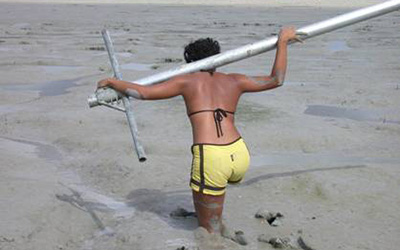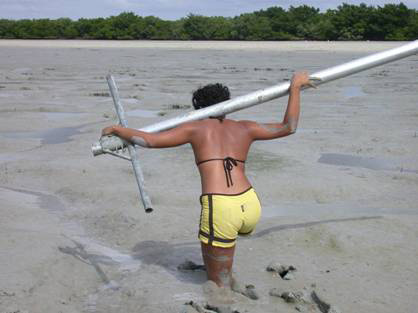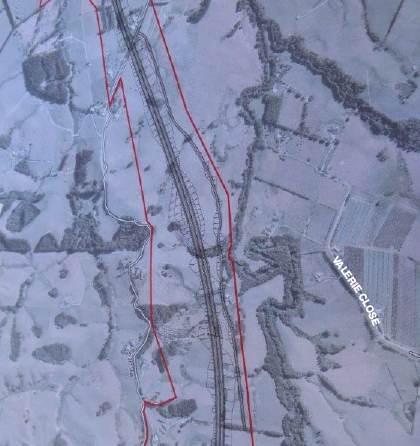Only honourable option to oppose in full


Cross for Young to Bear: While the latest report of Intergovernmental Panel on Climate Change is claimed by some to be alarmist, it is in fact ‘tragically conservative’. Here a field assistant of Professor Harold Wanless, who is an expert on South Florida’s vulnerability to sea-level rise, carries a core sampler into position. image University of Miami
The best strategy might have been to support the proposal in full. That way, the Pūhoi–Warkworth motorway board of inquiry might have been more receptive to the opportunity for a large-scale trial of open-ground indigenous plants.
Realistically, it was the only impact the society is likely to have on the project but Mahurangi Action chose to not beat about the bush, and opposed the proposed motorway in full, including because of its short- and long-term contribution to greenhouse gas emissions, to which road transport, globally, is the single biggest contributor. It is projected that anthropogenic global warming will bring extreme rainfall events of increasing frequency and intensity, which can only exacerbate the Mahurangi Harbour’s already elevated sediment accumulation rate.
In addition to the long-term impact on the catchment, construction of the motorway will expose the harbour to its greatest influx of sediment since deforestation, should extreme rainfall events coincide with peak open earthworks. The risk, Mahurangi Action has been assured, is statistically very low, but it ultimately comes down to luck. On average, only slightly more than one storm of tropical origin per year hits Northland or Auckland, with most striking in February and March, but luck can be cruel. On 27 February 2004, the day the Warkworth Rotary International was attempting to hold the 18th of its hugely successful charity regattas at Kawau Island, the event was bankrupted by a weather bomb, and hasn’t been held since. A month earlier, Mahurangi Action had held a one-off Mahurangi Regatta Ball, as the grand finale a summer of events celebrating the 150th anniversary of Warkworth’s founding. This was the stimulus for reviving the Mahurangi Regatta Prize-Giving Dance, which, along with the regatta, had ceased during World War II. Mindful of the Kawau Island catastrophe, where marquees were ripped up and deposited into the trees, the society took pains with the format so that cancellation of an event would not prove financially ruinous. But rather than enjoy Rotary’s 17-year run, it was only the seventh summer before Wilma scored a direct hit on the Mahurangi Regatta. And besides the weather being too heavy for even the most gung-ho of sailors to set sail from the Waitematā, the road to the regional park, where thousands of picnic-packing regatta spectators would otherwise have gathered at Sullivans Bay, was all but severed by a subsidence.

Age and Anthropogenic Global Warming: The implications of greenhouse gas emissions are neither intuitive nor palatable, as so graphically displayed here in the trend for younger people to be better, than those older, at comprehending the moral issue of the millennium. chart Crikey
That State Highway 1 between Pūhoi and Wellsford is inadequate and dangerous is, of course, not disputed. But the quickest way to reduce head-on crashes on that road is by immediately installing wire-rope median barriers, and other proven and cost-effective measures detailed by the Campaign for Better Transport in its Operation Lifesaver document. Longer term, much smarter and less greenhouse-gas-emitting solutions exist, to the capacity limitations of the existing highway, than extending the motorway farther and farther north. An immediate measure would be to prohibit, on holiday weekends, the use of passing lanes except by emergency vehicles and buses. The reason that the Northern Busway is such a success is that its patrons know that they are enjoying the better mode transportation, as they sail by literally looking down their noses at the unfortunate motorists, mostly one to a car, barely moving in lane after lane of peak traffic. By being prohibited from using passing lanes, motorists will be given pause to consider travelling to their holiday destination by coach, in the relaxed company of family and friends, and a considerable cause of holiday road-rage and accidents would be eliminated. To boot, the benefit to emergency vehicles is obvious. Prioritising passing lanes in this way would be complimentary to the increasing use of urban bus lanes, which itself could be substantially enhanced with active transit signal priority systems, whereby traffic lights prioritise the passage of buses through intersections.
During weekdays, the proposed motorway would largely be used by commuting motorists, given that Auckland Council has ordained that Warkworth is to be a satellite growth centre, in what appears to have been passive acceptance of the government’s roads of national significance programme, directly contrary to its avowed compact city imperative. Meantime, the smart use of commuter buses between Warkworth and a Northern Busway station is already considerably overdue.
In 2004, the Auckland Regional Council announced a 5-year ‘Mahurangi Action Plan’ to kick-start riparian fencing and planting, following 10 years of studies it had commissioned to benchmark a catchment subject to very little development pressure. The regional council knew a lot about catchments subject large-scale earthworks, and expected Mahurangi’s to be near pristine. The stress observed in the benthic communities was such that, in some of the areas studied, cockles and horse mussels had ceased breeding completely. At first blush, the regional council’s $3 million budget seemed generous. However, from a handbook on riparian restoration it distributed, published with support from Fonterra, two things were clear: If all the rivers, streams, seeps and wetlands that should be fenced and planted were, the budget would barely scratch the surface; and the cost of indigenous plants was an eye-watering ten times greater than for good quality radiata pine seedlings.

Going the Extra Mile: Rather than build a mile-long access road along the steep hillside between the proposed motorway and the Mahurangi River, generating further sediment, the New Zealand Transport Agency should be creating a broad riparian management zone, planted in indigenous trees, including to help offset a modicum of the greenhouse gases the project would generate, during and after its construction. aerial NZTA
The quest to understand why radiata pine was so economic led to Dr David Bergin, late of crown research institute Scion, and former Forest Research Institute head nurseryman Jaap van Dorsser. The explanation for the price difference was the fundamentally different nursery methods employed. Radiata pine seedlings are raised ‘from the tractor seat’ in large open-ground beds, their root systems mechanically pruned and conditioned subterraneously before being lifted bare-rooted for transplantation. From the late 1950s, van Dorsser successfully adapted the radiata pine method, which he’d initially developed for eucalypts, for the large-scale production of indigenous species. Tens of thousands of plants were raised and established with the method, but due to the subsequent privatisation of the New Zealand Forest Service, this work on indigenous species, which should have resulted in a sustainable indigenous forestry industry, was discontinued.
A $135 000 grant to Mahurangi Action by the Sustainable Farming Fund enabled the first-ever scientifically designed trials to compare the establishment performance of open-ground and container raised indigenous plants. The trials, conducted in the Mahurangi and Weiti catchments, which successfully demonstrated that open-ground indigenous plants established as successfully as their much more expensive planter bag or pot raised counterparts. This work was noticed by the Lake Taupō Protection Trust, which funded further trials that, in addition to confirming those in the Auckland region, revealed that the planting costs of the open-ground plants were halved—a planter could carry four to five times the number of plants. Supplier of the plants for all the trials, Taupō Native Plant Nursery, can now offer open-ground plants, for large-scale plantings, at a fifth of the cost of pot or planter bag raised plants. Hillson root trainer raised plants were also involved in both sets of trials, but performed so poorly as to not be cost-effective.
The emphasis here on economics should not give the impression that open-ground plants are in anyway inferior to the more expensive container-raised plants. On the contrary, the root systems of the later are frequently compromised due to root circling, resulting in poor growth prospects for such specimens. Bare-rooted plants, however, must be planted within days of being lifted from their open-ground beds. While this is standard forestry practice and presents few problems in large well-managed projects, the method is less well suited to small casually managed volunteer projects.
Mahurangi Action is encouraged by the New Zealand Transport Agency’s response to its request that open-ground raised plants be considered for use in the proposed project, as per designation condition 36c viii:
Consideration of the suitability of sourcing planting raised via the open-ground forestry method, including availability and cost-effectiveness
Ideally, should the project proceed, large-scale trails involving at least 100 000 plants would be established—ten times the number involved in the Taupō trials. The trials would pay for themselves in reduced plant and planting costs. Again, ideally, an even greater percentage of open-ground plants would be deployed, and with the savings a greater area be planted. An example of such an area is where the designated route runs close by the Mahurangi River, south branch, in the vicinity of Valerie Close. The agency currently plans to build an access between the proposed motorway and the river. Instead, this area should be retired from grazing and be reforested with indigenous species to create a broad riparian management zone.
Summary
- Mahurangi Action asks that the project be declined primarily because of the urgent imperative to radically reduce greenhouse gas emissions.
- Mahurangi Action asks that the project be declined because of the risk of catastrophically exacerbating the Mahurangi Harbour’s already elevated sediment accumulation rate.
- Mahurangi Action asks that, should the board approve the project, that a large-scale trail of open-ground plants be undertaken, and that consideration be given to additional riparian plantings such as all that land between the designated route and the Mahurangi River where the two run close-by in the vicinity of Valerie Close, thus obviating the need for the proposed access road within that margin.

In reply to Peter Georgetti ‘Important Infrastructure’ (Mahurangi Matters 15 January 2014) Conspiracy of convenience leads to strategically inappropriate outcomes. Our elected representatives derive much of their political power by intentionally frustrating our haste-obsessed economic-rationalist culture, and then by offering – as they are doing with this proposed extension of the motorway from Puhoi, a reward for our acceptance of their solution-with-comprises i.e. re-allocating funding from local roading extensions and improvements, to their major political corporate-beneficiery-sponsors who stand to gain directly by ‘winning’ contracts during the construction phase or by the provision of infrastructure thereafter. For various reasons, lack of attention by our media among them, the vast majority of New Zealanders remain oblivious to some of the big-picture issues that a real government should/would be equipping us to deal with, and which should be part of any discussion about such a major infrastructural proposal. New Zealand is currently burning through more than $21,000,000 per day in imported oil, more than 80% of it to fuel one of the world\’s least efficient transport fleets. In 2011 the chief economist of the International Energy Agency warned that New Zealand urgently needs to reduce its vulnerability to what are only going to become ever-increasingly expensive post peak (2006) oil prices. The IEA are also warning NZ of the need to urgently reduce our disproportionate contribution of greenhouse gas emissions that are negatively affecting our only planet’s climate. In 2008 Trevor Mallard, Labour’s Minister of Energy stated that they weren’t considering peak oil in their energy and transport strategy because they didn’t expect it to occur until sometime after 2030 – when oil prices might be expected to rise to US$35 per barrel. The IEA now admits that the peak in conventional oil production passed sometime around 2006 and oil has been over US$100 per barrel for more than 3 years. The 2009 Ministerial Briefing on Oil Prices and Transport Sector Resilience was not made available to the public until a request for it was made through the Official Information Act and similarly the 2011 Briefing to the incoming Minister of Transport has recently been re-released with whole sections on rail and risks to New Zealand that had been redacted (i.e. blacked out) re-written. In 2009 the Ministry of Transport commissioned the Bolland Report to provide independent advice on the costs and benefits of rail freight, which found that there is a significant economic benefit in favour of transporting goods over long distances by rail. Again the Official Information Act was needed to get it released and it does not seem to have influenced this government’s attitude to rationalising some of our regional railways out of existence. Transport engineers estimate that it takes around 9600 light vehicles to cause the same damage done by one truck and trailer unit. A road-user charging system that more accurately reflects tonnage carried over a given distance would encourage rationalisation – and therefore more efficiency in our transport system. Considering the aforementioned points, wasting our resources to replicate existing roading infrastructure, while failing to make best use of existing and potential infrastructure is poor strategic planning. Short-term economic rationalist thinking is not only inappropriate, it is dangerous to the long-term strategic interests of New Zealand. If this National ‘government’ really wants Northland to develop, they need stop playing politics and prioritise funding the completion of the already designated and consented rail connection from Oakleigh to Northport (and do the remedial work on the Makarau tunnel) that will obviate the need for increased numbers of inefficient, polluting and dangerous trucks on our roads, thereby reducing congestion and the need for more roads The Way Forward NZ Contact Alan Preston 4 Insley Street, Mangawhai 0505 Northland, New Zealand. Tel +64 9 4315389 Mob +642102377242 E-mail: thewayforwardnz@gmail.com Web-site: http://www.thewayforwardnz.org.nz